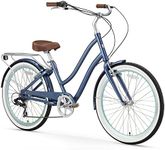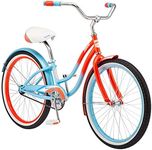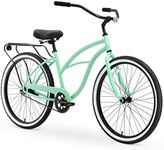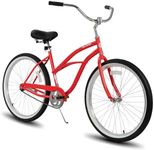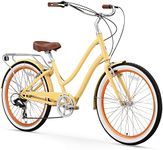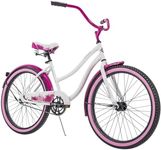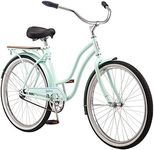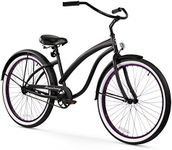Buying Guide for the Best Womens Cruiser Bikes
Choosing a women's cruiser bike is all about comfort, style, and how you plan to use it. Cruiser bikes are designed for relaxed rides, often on flat terrain like city streets, boardwalks, or parks. They are known for their upright seating position, wide handlebars, and comfortable seats. When picking the right cruiser bike, think about where you'll ride, how often, and what features will make your rides enjoyable and easy.Frame Size and GeometryFrame size refers to the overall dimensions of the bike, which should match your height and leg length for a comfortable ride. Cruiser bikes often have step-through frames, making it easier to get on and off, especially if you wear skirts or dresses. To pick the right size, stand over the bike and make sure you can touch the ground with your feet. If you feel cramped or stretched out, try a different size. The right frame size ensures comfort and control, especially on longer rides.
Wheel SizeMost cruiser bikes come with 26-inch wheels, which are great for stability and smooth rides on flat surfaces. Some smaller models use 24-inch wheels, which can be easier to handle for shorter riders. If you want a more nimble bike or are on the shorter side, look for 24-inch wheels. For most adults, 26-inch wheels offer a good balance of comfort and ease of use.
GearingCruiser bikes can have single-speed or multiple gears. Single-speed bikes are simple and low-maintenance, perfect for flat areas and casual rides. If you plan to ride on hills or want more flexibility, look for a bike with 3 or 7 gears. More gears make it easier to pedal up inclines or go faster on flat stretches. Think about your local terrain and how much effort you want to put into pedaling when choosing the right gearing.
BrakesCruiser bikes typically have either coaster brakes (pedal backwards to stop) or hand brakes (squeeze levers on the handlebars). Coaster brakes are simple and require less maintenance, but hand brakes offer more control, especially on hills or in wet conditions. If you want a classic, easy-to-use bike for flat areas, coaster brakes are fine. If you want more stopping power or plan to ride in varied conditions, hand brakes are a better choice.
Seat ComfortA hallmark of cruiser bikes is their wide, cushioned seats. The seat should support your weight comfortably and absorb bumps from the road. Some seats have extra padding or springs for added comfort. If you plan to ride for longer periods, prioritize a well-padded seat. Try sitting on different seats to see what feels best for you, as comfort is very personal.
Handlebar StyleCruiser bikes usually have wide, swept-back handlebars that let you sit upright and relax your shoulders. This style is great for comfort and visibility. Some handlebars are more curved or adjustable, which can help you find the perfect riding position. If you have back or shoulder issues, look for handlebars that allow you to sit up straight and keep your arms relaxed.
WeightCruiser bikes are often heavier than other types of bikes due to their sturdy frames and wide tires. A heavier bike can feel more stable but may be harder to carry or maneuver, especially up stairs or onto bike racks. If you need to lift your bike often, consider a lighter model or one with an aluminum frame. If stability is your main concern, a heavier steel frame might be preferable.
Accessories and FeaturesMany cruiser bikes come with or can be fitted with accessories like baskets, racks, fenders, and kickstands. These features add convenience for carrying items, keeping you clean from road spray, or parking your bike easily. Think about what you'll use your bike for—if you plan to run errands or carry groceries, a basket or rack is helpful. Fenders are great if you ride in wet conditions.
